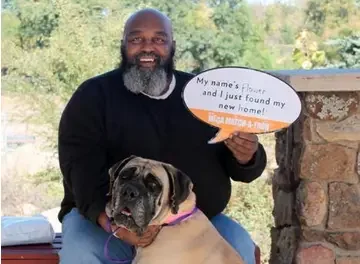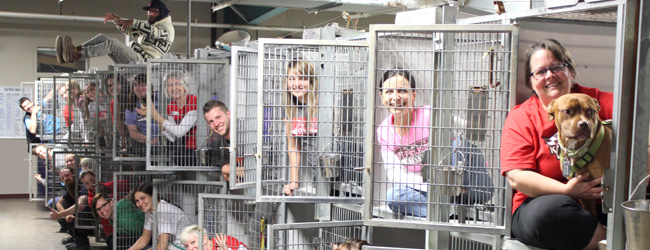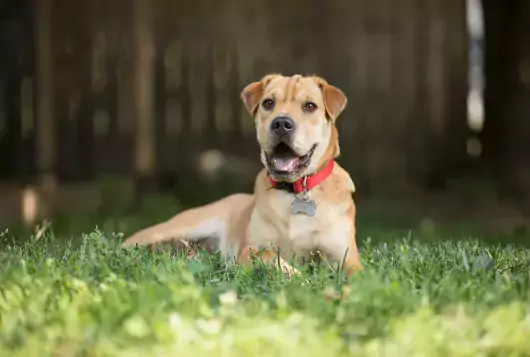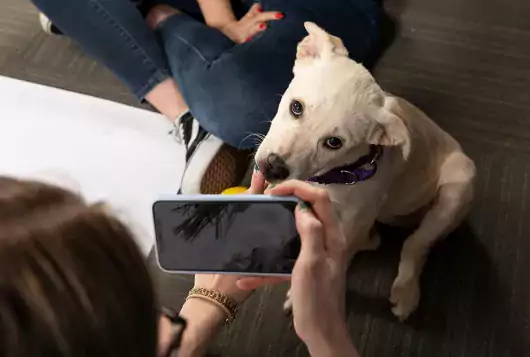Leveraging Facebook to Promote Your Big Adoption Event

"Cute animals are king on Facebook," says ASPCA Senior Social Media Manager Olivia Melikhov. Armed with that knowledge and some tried-and-true engagement tips, you can capitalize on the social media giant to find homes for your adoptable animals.
Ways to Increase Your Reach
Facebook promotes posts that have a lot of interaction, so the more you can get your supporters to comment and post pictures and videos on your page, the better. With a little experimenting – and a lot of cute pictures and videos – you can get your message in front of your target audience. Here are some great ideas to get your creative juices flowing.
Contests: Facebook contests can drive engagement, and now it's possible for you to run your own contest without having to drive the contest traffic to a third-party website. Post on Facebook that you are giving away a t-shirt (or any item) and ask people to respond with their name (or an answer to a question) in order to enter. You can then randomly select a name from the list of people who post.
Calls to Action: Include a call to action in your posts. Ask people to comment and share, and let them know they're helping increase your reach.
Hashtags: These are quick identifiers for trending topics and a way for people who may not already be supporting you to find you. Create your own hashtag names to promote and organize your own events and topics, and post relevant content under other people's hashtags to expose your event to new viewers. For example, if "#2015 new cars" is trending on Facebook, you can post something under that hashtag encouraging people to drive their new (or old) cars over to your mega adoption event to meet their new best friend.
Time Management: Experiment with publishing your posts at different times of the day. In general, Thursday is the most popular day to post on Facebook. Try posting after 7 p.m. on weekdays and on the weekends, and check your free Facebook analytics to see if certain times are better for engagement than others.
Reposting: The majority of your posts should be original, but don't hesitate to repost others' relevant viral posts – they can boost your own reach and engagement.
Before Your Event
- Create a hashtag name for your event that you can use on Facebook and any other social media outlets.
- Design a shareable graphic with a compelling high-resolution image that has text with all the event details (name of event, when, where, event hashtag and your website). Picmonkey.com is a free and easy website you can use to create your graphic – do be sure you own the rights to the image!
- Post your share graphic on your website one to two weeks in advance of your event, making sure to tag all sponsors and partners. Ask your sponsors and partners to share your graphic, too.
During Your Event
- Designate one person to be in charge of Facebook posts and have him or her frequently post pictures and videos throughout the event.
- When taking pictures with your smartphone, Melikhov suggests emailing yourself the photos directly from your phone, opening the image from your email and selecting the largest image option before posting to Facebook. This will help guarantee the best picture quality in your posts.
- Use hashtags in your posts to make it easier for people to follow your progress.
After Your Event
- Create a Facebook photo album with all the event pictures. Share the album with staff, volunteers, partners, sponsors and media. Your album will also be a useful tool for future promotions, partnerships and sponsorships.
- Write posts thanking your volunteers, staff, partners and sponsors. Make sure to tag sponsors and partners by adding the @ symbol before their name.
Successful Posts
Although there is no "perfect" Facebook post, according to James Stewart-Meudt, ASPCA's Social Media Coordinator, there are a few things most successful posts have in common:
- Either a photo or a video. Photos should be a high resolution and you must own the rights before posting. For videos, if possible, post a native video file (one that's downloaded from your own computer or smartphone). Facebook now allows original videos to start playing without clicking on them, which is a huge attention-grabber when people are scrolling through their newsfeed and see your post in motion.
- When it comes to text, less is more. Use words sparingly (140 characters or less) and use a free URL trimming service like bit.ly to reduce the number of characters in your links.
Pune Dracker, ASPCApro's Director of Editorial and Content Services, has been following the ASPCA's Mega Match-a-thon contestants on Facebook for the last two years and has found that when it comes to large-scale adoption events, posts with certain kinds of pictures are almost guaranteed to invoke online engagement.
- Preparation: To build excitement for the event, post pictures of animals being groomed or of the staff getting ready for the big day – anything that captures the exciting prelude to the event.
- Celebrations: Dracker says posts with pictures "making the adopters feel like stars" are very successful. Make sure to get everyone in the new family in the shot – people love to see animals with their new loved ones. Most of these celebrations include some kind of signage like a speech bubble sign held up by the adopter proclaiming, "I just saved a life!" or a sign held next to the pet saying, "I just found my new home!"
- Empty cages: Nothing gets people more excited than seeing pictures of empty kennels after an adoption event, like this one from KC Pet Project that went viral.

- Men with kittens: We are not sure of the psychology behind it, but besides pictures of empty cages, nothing gets more likes and shares than a man holding a kitten or cat. Make sure you seize on this phenomenon and post as many men adopting cats as possible.
- Long lines: Pictures showing a line of adopters out the door show the popularity of the event, making everyone want to be a part of what you're doing.
- Group shot: The tired, happy faces of your staff and volunteers at the end of the event speak volumes. You have told your story on Facebook – and it has a happy ending.
More Lifesaving Resources
Read about how to choose the best location for a big adoption event
Get ideas for creative ways to find funding for your big adoption event
Find out what successful shelters would do again – and not do – at a big event
We have lots more on this subject:




